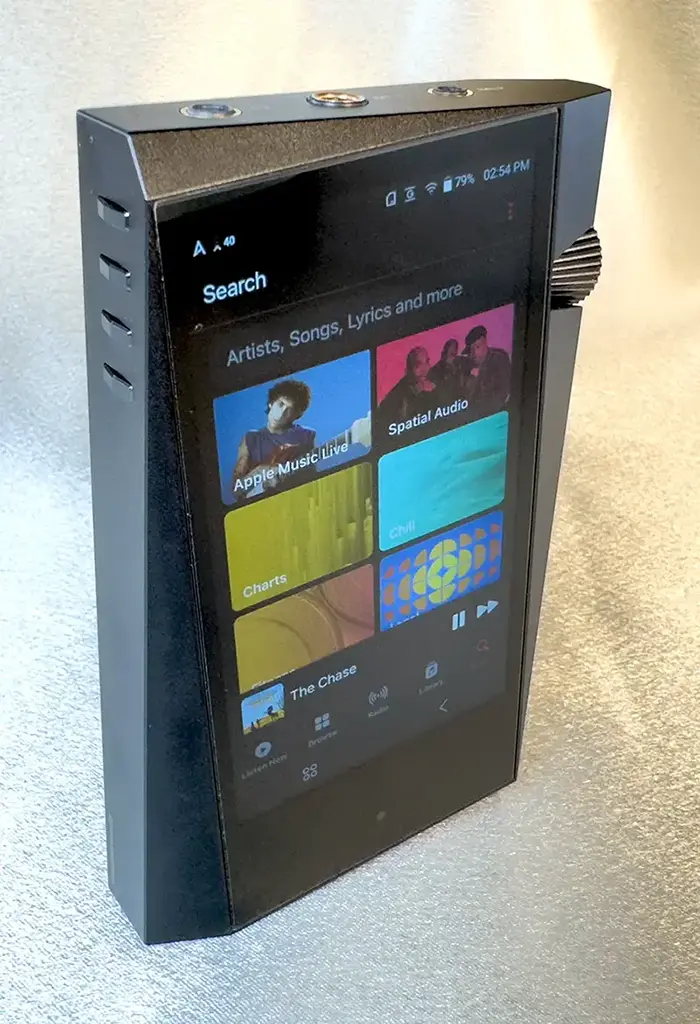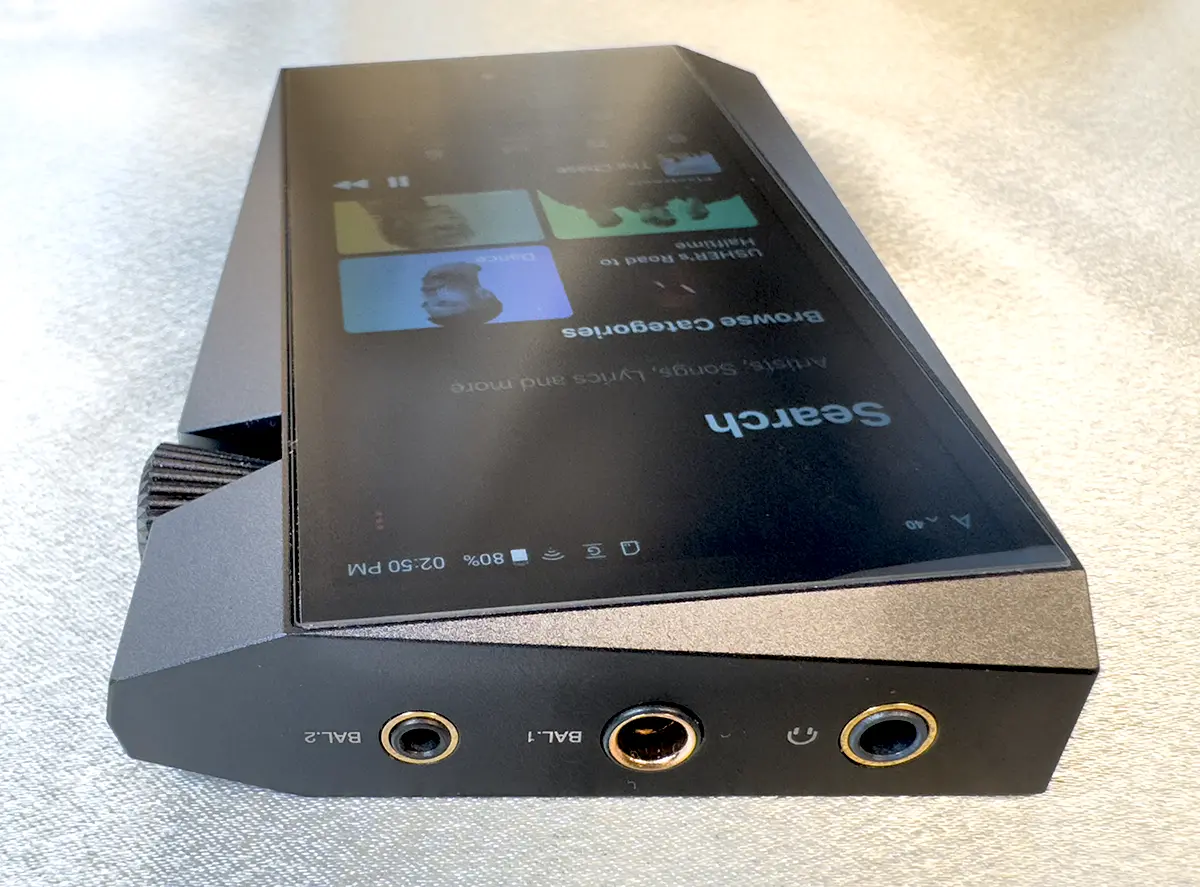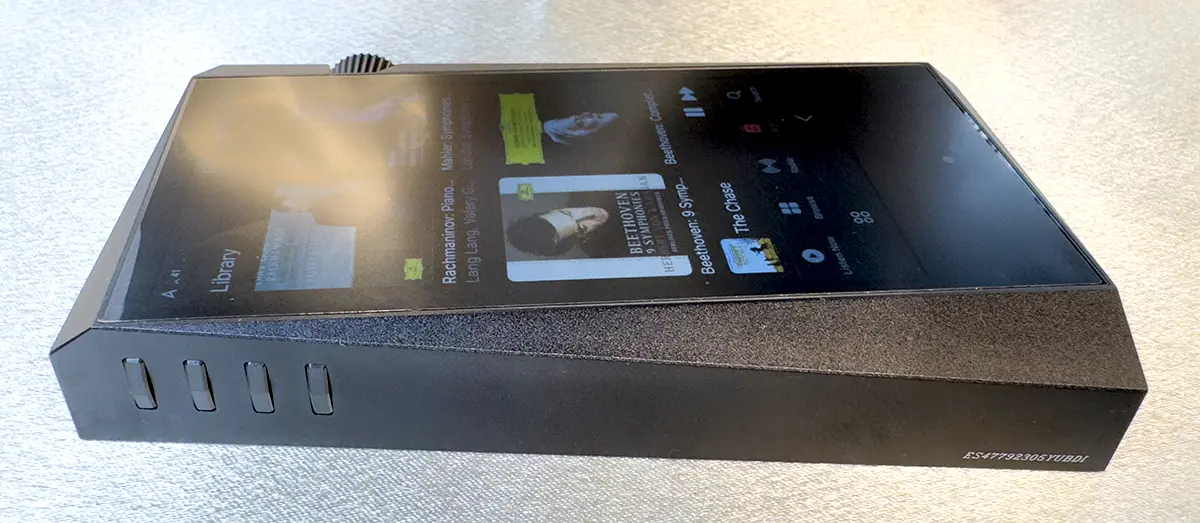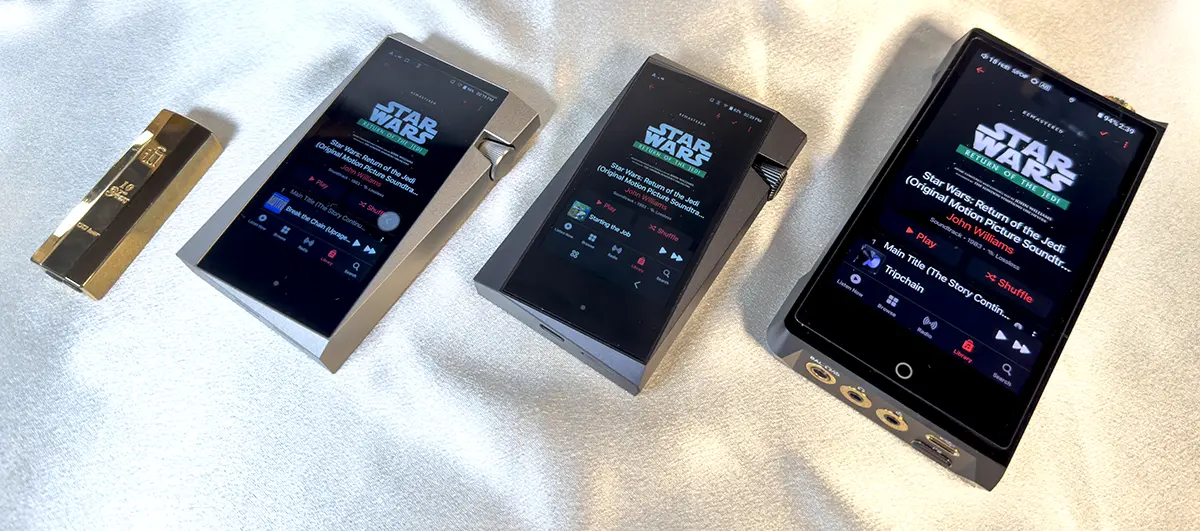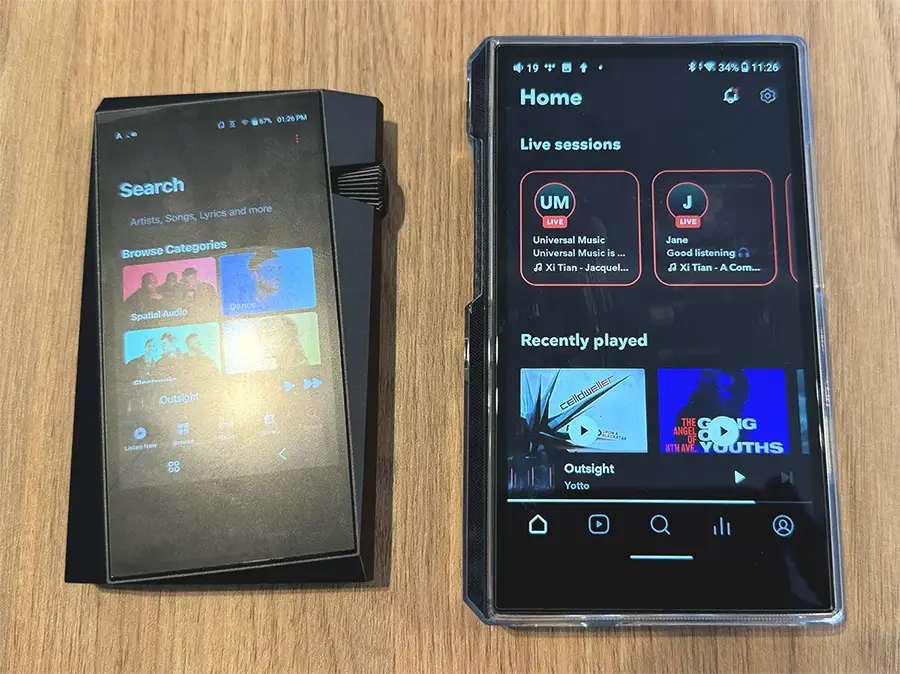By
Nick Smith, 10th October 2023
They say good things come in small packages.
You wouldn't know it observing the trend in phones, where "Bigger Is Better" has been the market mantra for some time. As a former iPhone Mini user I was disappointed when Apple discontinued the Mini earlier this year, but it followed an established trend of users gravitating towards larger devices in recent times.
Unsurprisingly Digital Audio Players have ballooned as well. 2015's Astell & Kern flagship AK380 was 230 grams, compared to last year's SP3000 more than doubling that at 493g. Then you have behemoths like the 610g
FiiO M17 & recently released 650g
Cayin N30LE. When will the madness end?!?
Truthfully there's nothing wrong with larger DAPs, especially if you mostly listen at home... but what if you choose to prioritise portability?
That's where Astell & Kern's storied line of micro players comes in. Having previously owned the SR70 MKII, SR15 & SR25, it's fair to say I'm an ardent fan of their charms with absolutely no intention of hiding my bias. You simply have to experience one yourself to understand why they're so much fun.
Which brings us to the present - just weeks ago I pulled the trigger on a shiny new
Astell & Kern SR35 from
Addicted to Audio and have been enjoying it ever since. At USD $799 it's far from the cheapest micro DAP on the market, but undoubtedly one of the best and you're about to discover why.
Tech Specs & Battery Life
At the heart of the SR35 lies four Ciruss Logic CS43198 DACs, two of which can optionally be switched off to extend battery life. Featuring two gain levels, in Hi-Gain mode the DAP outputs 6Vrms from its' 4.4mm balanced jack with 2.7ohm impedance & 3.1Vrms from the 3.5mm unbalanced socket with 1.1ohm impedance. DSD up to DSD256 & PCM up to 384kHz are supported, and the SR35 features Bluetooth 5.0 with aptX HD & LDAC. 64GB of onboard storage is present with Micro SD cards up to 1TB supported.
In terms of battery life, A&K claims the SR35 lasts 20 hours playing local files from the 3.5mm jack in low gain, dual-DAC mode - essentially a best case scenario.
More realistically, if you mostly stream as I do these days and run the SR35 in quad-DAC mode with Hi-Gain enabled (for optimal audio performance) I estimate 7-9 hours would be more accurate depending on your streaming app, volume level, amount of screen on time & brightness level. Having said that, the ability to disable two of the DACs & lower the gain level to extend playtime during long trips or commutes are handy options.
Ergonomics
If you've never owned an Astell & Kern micro DAP you really need to hold one in your hand to fully understand the appeal.
The first thing you'll notice is the slanted screen. This was something that initially dissuaded me from purchasing the SR15 years ago, because in photos it looks so awkward & potentially annoying. In practice, the slanted screen is something you get used to almost immediately. Tilting the DAP very slightly in your hand to straighten the screen's orientation is something I began doing without thinking almost straight away, and mentally the slant no longer registers at all.
The second thing you'll feel -particularly if you're accustomed to heavy & cumbersome flagship DAPs- is the remarkably small & light SR35 form factor. It really is a different experience holding a tiny 184 gram device that fits in the palm of your hand, making the SR35 is an absolute dream to use while commuting given how effortlessly it glides in & out of a pocket.
Where it really differentiates itself from other micro DAPs is in build quality - Astell & Kern haven't sacrificed their famed luxuriousness here, and you'll be pleased to learn the SR35 feels every bit as beautifully made as it's bigger brothers the SE300 & SP3000. The SR35 volume wheel deserves special mention, resembling the crown of an expensive mechanical watch and delivering a marvellously smooth action with just the right amount of tactile feedback.
Unfortunately space limitations prevent the volume wheel from acting as a power button as they do on A&K's flagship DAPs, which I find is the ideal arrangement. Instead the SR35 positions the power button on the left hand side -just above the Next/Play/Prev buttons- whereas previously the SR25 housed the power button on top, next to the balanced output jack.
No doubt including
both 4.4mm & 2.5mm jacks on the SR35 forced the power button's relocation, but I'd prefer to omit the 2.5mm jack and keep the power switch in its' place. Locating the power button directly next to control buttons is never ideal, especially when blindly fumbling with the DAP in one's pocket, but many A&K customers probably still own cables with 2.5mm plugs I suppose.
Usability
There's an interesting mix of good & bad here.
On the one hand using such a tiny device that sounds surprisingly good is a splendid experience I absolutely wouldn't trade for any other DAP on the market when I'm out & about, especially on noisy trains when I struggle to hear the sonic improvements heavier, burdensome flagship DAPs deliver but absolutely
would notice the size & weight penalty and in many instances extra heat they generate.
I'll talk about sound later, but the SR35's biggest compromises are actually its' screen & CPU.
The screen is a mere 3.6", so everything is smaller than you're accustomed to on the 5" screens that've become the norm for modern DAPs. Depending on your age or eyesight this may be a deal-breaking factor. I've acclimated to the size but certainly find it less enjoyable than using a larger screen, and occasionally frustrating when using the smaller on-screen keyboard.
Furthermore screen brightness & contrast levels, viewing angles and colour saturation are below what you may expect from mid-priced DAPs, let alone flagships. It's isn't a
bad looking screen by any means, but modern smartphones have driven our screen expectations far higher than a DAP of this size can hope to match.
The other big SR35 compromise is its' CPU, which is fairly slow due to size & battery limitations. I predominantly stream via Apple Music these days, and scrolling through long playlists isn't silky smooth as it is on a flagship DAP or smartphone. Album art icons can take a fraction of a second to load, and when streaming the first song from a playlist it will often take a second or two for play to briefly commence, then there will be a one second pause, then play will continue to the end without interruption, and subsequent songs will generally play smoothly. I've grown used to that stutter at the beginning, but you may find it annoying.
It should also be noted the SR35's internal modem & corresponding wifi performance is slower than most mid-range DAPs, let alone flagships. This will especially be noticed when you're downloading offline files, as hi-res albums in particular can be quite slow to download. Having said that, running Apple Music while tethering the SR35 to my iPhone via a 4G connection is perfectly usable, but not as smooth or responsive as it would be on a larger device.
Sound Performance
The SR35 has a fairly smooth overall character that'll be familiar to anyone who's owned an Astell & Kern player before. The midrange in particular features A&K's signature coloration which seems to aid vocal articulation, however I do find vocals could use a little bit of extra body.
Treble is never harsh but is admirably detailed for such a small player. Resolution is correspondingly capable, without really calling attention to itself or matching that of players worth thousands of dollars. I do not listen to the SR35 with the impression of missing any important details in the music, but nor are minute nuances presented in a way that genuinely impresses me.
Bass is impressive. In fact it feels like bass has been given small lift above neutral, particular in the sub region, which suits my taste perfectly. However bass texture could be improved, I wouldn't call it poor enough to ruin my enjoyment by any stretch but really awe-inspiring rumble is to be found elsewhere.
As for technical prowess, soundstage width is quite decent and does not feel congested at all. There is some stage depth and height, but not a great deal and this is an area where expensive DAPs demonstrate where the extra money goes. Dynamics however are very good - one aspect of the SR35's performance that really impresses me. Background blackness is also respectable for such a small player.
I almost get the feeling the SR35's built-in headphone amp is doing a lot of the sonic heavy lifting, performing far beyond what I expected from such a tiny DAP, and that the CS43198 DACs themselves are the bottleneck. There's nothing inherently wrong with them, but they just can't render music in quite the startlingly-beautiful manner DACs found in flagship players can.
That said, with the right IEMs the SR35 sounds far better than such a tiny package has any right to. I never really feel like my musical enjoyment is being compromised by listening to it, but that feeling of being blessed by a very special musical experience one receives from a TOTL DAP is of course absent.
Source Comparisons
Astell & Kern SR25 MKI - 178 grams (USD $700)
This is probably the most important comparison if you own the original SR25 and have been eyeing the SR35. Like me you may have been tempted by the SR25 MKII but felt it wasn't enough of an improvement to warrant upgrading despite the 4.4mm socket being tempting.
The SR35 is a more dramatic step up. Though both players feel almost identical in the hand, the performance gap is significant. The SR35 has superior note weight, much deeper bass impact, better soundstage depth and superior dynamics - those are the improvements that really jump out at you.
More nuanced enhancements are the SR35's more effortless resolution with trailing echoes of notes easier to pick up, slightly more midrange presence and more sharply defined transients. The SR25's character is more digital with a flatter, one-note feeling - essentially it sounds like micro DAP, a trait the SR35 defies much more effectively.
In terms of usability, the screen is the same size on both players and ergonomics haven't changed significantly. I was hoping the SR35 would include a faster CPU but performance feels similar.
iFi Go Bar 10th Anniversary - 64 grams (USD $500)
What's immediately apparent here is how far dongles need to progress to match the performance of even a small DAP like the SR35.
The Go Bar has a vastly higher noise floor which is plainly evident during quiet passages, its' stage is smaller across all dimensions but especially in width, note weight is lower and the in general the sound feels mushier and more mechanical with flatter dynamics.
The Go Bar competes surprisingly well when it comes to resolution, yet the trailing off of individual notes are a tad more muted. Instruments are also more poorly defined in space, and have a tendency to blend together particularly during busy passages. I do really enjoy the Go Bar's tonality, but find it handily outclassed by the SR35 in all other areas.
Cayin N8ii - 442 grams (USD $3499)
The N8ii competes in a different weight division to the SR35, figuratively & literally. Far less comfortable to pick up & hold, but its' 5" screen is immensely brighter with superior contrast & colour. The N8ii's CPU & internal modem also deliver a smooth smartphone-like experience, highlighting the SR35's deficiencies in those areas.
Sonically the N8ii boasts numerous improvements over the SR35 which tend to be smaller than you'd expect in individual areas, but their net effect adds up to a much more refined sonic experience.
Delivering a pronounced V-shaped sound, the N8ii's thunderous sub bass is much more impactful than the SR35's and treble is accentuated more as well, though I do find can be a little bright at times. The N8ii's other shortcoming is its' soundstage width - below that of many flagship DAPs and similar to the SR35's, but the N8ii's stage is taller and much deeper.
With a blacker background, superior dynamics and more defined imaging & separation, instruments also sound larger on the N8ii with a greater sense of space surrounding them. During A/B tests the SR35 can feel mushier & more congested, and moderately less resolving though I expected the difference in detail retrieval to be larger than it is. Despite its' V-shape nature the N8ii's ROHM DACs deliver a richly organic texture, leaving the SR35's presentation feeling stiffer & more mechanical.
I also paid a visit to
Addicted to Audio in Melbourne to compare the SR35 to a few more DAPs from their lineup. Please do bear in mind discerning subtle differences between players is more difficult in this noisier environment so these impressions will be briefer. My
Penon Impact IEMs were used for the comparisons, which required a volume level of 40 out of 150 on the SR35, and all DAPs were run in their highest gain mode.
FiiO M11 Plus - 295 grams (USD $600)
This is my first time hearing the M11 Plus, and right off the bat it impresses me far more than its' asking price suggests - if you're on a budget and insist on a DAP with a larger screen you can do much worse than this.
Physically the FiiO DAP is quite small but solidly built with the output jacks on the underside of the player. It lacks a volume wheel, instead providing + and - volume buttons. I'm not a fan of this approach, but you may not be bothered by it.
The M11 Plus has a V-shaped presentation reminiscent of the N8ii, delivering far deeper & more prominent bass than the SR35. The M11 Plus's ESS ES9068AS DAC also features a blacker background, but lacks the SR35 midrange coloration which make vocals feel richer. With the Impacts requiring a volume of only 19/120 it's clear the M11 Plus has power to burn.
Astell & Kern KANN MAX - 305 grams (USD $1200)
KANN MAXX is another medium sized DAP, and although quite short & narrow is very thick and definitely not light. Like every A&K DAP it feels absurdly solid & well-built, and its' unusually small & squat form factor is quite comfortable in the hand. With the Impacts requiring just 25/150 volume it's clear this is a powerhouse not lacking grunt.
Unsurprisingly then KANN MAXX's sound is characterised by a beefy bottom end, along with fairly prominent treble. However MAXX's dynamics do not impress me, but resolution is very good. MAXX's stage is definitely wider than the SR35's but not much deeper, though I find the SR35 sounds a little mushier overall.
The M11 Plus seems to have superior dynamics, but MAXX feels a bit more refined, resolving & natural than the FiiO player. Unfortunately MAXX strikes me as a half-way house that's neither small nor cheap enough to be attractive, nor sonically impressive enough unless you absolutely require a beefy built-in amplifier - I haven't had have the opportunity to test MAXX with headphones but assume it drives them quite well.
Astell & Kern SE300 - 317 grams (USD $1900)
As A&K's first R2R DAC player SE300 is something of a departure for the brand, and is priced at a not-quite-flagship level.
The usual impeccable A&K build quality is evident as expected, but the Impacts requiring 40/150 volume (same as the SR35) suggests the SE300's built-in amp may not be as powerful as many flagship players. However I do much prefer the SE300 in hand to the SP3000 which has always felt 100g too heavy for my taste, whereas at 317g the SE300 represents a superb tradeoff between weight & performance.
Like the N8ii, sonically the SE300 is a big step up from the SR35. It's characterised by a very smooth, organic & refined R2R sound with relaxed treble & terrific bass impact that is very easy to listen to without fatigue, yet delivers all the detail & nuances one could want. Unfortunately the slightly rounded R2R transients probably don't synergise terribly well with the Impacts' more restrained treble that can benefit from a bit more excitement, but I've been impressed by the SE300 enough to earmark it as a DAP I definitely plan on demoing with other IEMs in future.
Conclusion
It's tough verbalising why I love the SR35 so much, even more than its' predecessors. There's something oddly compelling about these little DAPs that owners of Chihuahuas & Mini-Minors probably understand.
Admittedly with TWS earphones gaining popularity its' appeal may not be as compelling as it once was, yet the sonics emanating from the SR35 with a nice pair of IEMs obliterate anything my Airpod Pros are capable of, and the entire package costs very little in bulk & weight.
Usability is compromised by the small screen & slow CPU, tradeoffs you may be less willing to accept than I am... but in terms of sound, this is the first A&K micro DAP which to my ears delivers a proper sonic experience, something I can listen to even at home and not feel immediately compelled to switch to a bigger & more expensive player. In fact, just recently a fellow Head-Fier remarked that A&K's new USD $4200
Aura IEMs sound shockingly good on the SR35 which has been my experience as well - proof synergy can often trump size & specs when it comes to pair ups.
I'll be terribly saddened if A&K eventually does away with their micro DAPs the way Apple did with the iPhone Mini. Consumers deserve options, we shouldn't all be pidgeon-holed into the same box because the majority of the market has a preference that may not suit our taste or needs.
Next time you visit your audio dealer I encourage you to give the SR35 a try. It won't sound as amazing as that shiny flagship DAP you've coveted, but just holding it in your hand may put a smile on your face.



